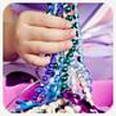About Lead
This page provides information on:
Sources of Lead at Home

Older Homes and Buildings
If your home was built before 1978, there is a good chance it has lead-based paint. In 1978, the federal government banned
consumer uses of lead-containing paint, but some states banned it even earlier. Lead from paint, including lead-contaminated dust, is one of the most common causes of lead poisoning.

Lead paint is still present in millions of homes, sometimes under layers of newer paint. If the paint is in good shape, the lead paint is usually not a problem. Deteriorating lead-based paint (peeling, chipping, chalking, cracking, damaged, or damp) is a hazard and needs immediate attention.
It may also be a hazard when found on surfaces that children can chew or that get a lot of wear-and-tear, such as:
- Windows and window sills;
- Doors and door frames; and
- Stairs, railings, banisters, and porches.
Be sure to keep all paint in excellent shape and clean up dust frequently. Read about simple steps to protect your family from lead hazards (PDF) Lead in household dust results from indoor sources such as deteriorating lead-based paint.
Lead dust can also be tracked into the home from soil outside that is contaminated by deteriorated exterior lead-based paint and other lead sources, such as industrial pollution and past use of leaded gasoline. Read more about lead dust.
Renovation, repair or painting activities can create toxic lead dust when painted surfaces are disturbed or demolished. Learn more about hiring lead-safe certified contractors.
Pipes and solder – Lead is used in some water service lines and household plumbing materials. Lead can leach, or enter the water, as water flows through the plumbing. Lead pipes and lead solder were commonly used until 1986. Read more about lead in drinking water.

Soil, Yards and Playgrounds
Lead is naturally-occurring, and it can be found in high concentrations in some areas. In addition, soil, yards and playgrounds can become contaminated when exterior lead-based paint from houses or buildings flakes or peels and gets into the soil. Soil may also be contaminated from past use of leaded gasoline in cars, from industrial sources, or even from contaminated sites, including former lead smelters.
Lead in soil can be ingested as a result of hand-to-mouth activity that is common for young children and from eating vegetables that may have taken up lead from soil in the garden. Lead in soil may also be inhaled if resuspended in the air, or tracked into your house thereby spreading the contamination.
Check the exterior of your home, including porches and fences, for flaking or deteriorating lead-based paint that may contaminate soil in your yard or be tracked into your house. To avoid tracking contaminated soil into your house, put doormats outside and inside all entryways, and remove your shoes before entering.
To reduce exposure to lead, after playing or working outdoors, EPA recommends that children and adults leave their shoes at the door or use door mats, and wash their hands. To keep children from playing in soil near your home, plant bushes close to the house.
Also, older playground equipment can still contain old lead-based paint, and artificial turf and playground surfaces made from shredded rubber can contain lead. Take precautions to ensure young children do not eat shredded rubber, or put their hands in their mouth before washing them. Read more on playgrounds and artificial turf fields.
Dust
Lead in household dust results from indoor sources such as old lead paint on surfaces that are frequently in motion or bump or rub together (such as window frames), deteriorating old lead paint on any surface, home repair activities, tracking lead contaminated soil from the outdoors into the indoor environment, or even from lead dust on clothing worn at a job site.
Even in well-maintained homes, lead dust can form when lead-based paint is scraped, sanded or heated during home repair activities. Lead paint chips and dust can get on surfaces and objects that people touch. Settled lead dust can re-enter the air when the home is vacuumed or swept, or people walk through it. To reduce exposure to lead dust, it is especially important to maintain all painted surfaces in good condition, and to clean frequently, to reduce the likelihood of chips and dust forming. Using a lead-safe certified renovator to perform renovation, repair and painting jobs is a good way to reduce the likelihood of contaminating your home with lead-based paint dust.

Products
Lead can be found in many products:
Painted toys, furniture and toy jewelry – That favorite dump truck or rocking chair handed down in the family, antique doll furniture, or toy jewelry could contain lead-based paint or contain lead in the material it is made from. Biting or swallowing toys or toy jewelry that contain lead can cause a child to suffer from lead poisoning.
- Read more on lead in toys and toy jewelry.
- Visit the Consumer Product Safety Commission for more information about lead in consumer products, including toys, and about recalls of lead-containing products.
Cosmetics – Visit the U.S. Food and Drug Administration’s web site to read questions and answers on lipstick and lead.
Food or liquid containers – Food and liquids stored or served in lead crystal or lead-glazed pottery or porcelain can become contaminated because lead can leach from these containers into the food or liquid.
Visit the Food and Drug Administration for more information on lead in food and containers.
Plumbing products – Materials like pipes and fixtures that contain lead can corrode over time.

Drinking Water
Lead can enter drinking water through corrosion of plumbing materials, especially where the water has high acidity or low mineral content that corrodes pipes and fixtures. Homes built before 1986 are more likely to have lead pipes, fixtures and solder. However, new homes are also at risk: even legally “lead-free” plumbing may contain up to eight percent lead.Beginning January 2014, changes to the Safe Drinking Water Act further reduced the maximum allowable lead content of pipes, pipe fittings, plumbing fittings, and fixtures to 0.25 percent. The most common problem is with brass or chrome-plated brass faucets and fixtures with lead solder, from which significant amounts of lead can enter into the water, especially hot water.Corrosion is a dissolving or wearing away of metal caused by a chemical reaction between water and your plumbing. A number of factors are involved in the extent to which lead enters the water including the chemistry of the water (acidity and alkalinity), the amount of lead it comes into contact with, how long the water stays in the plumbing materials, and the presence of protective scales or coatings inside the plumbing materials.To address corrosion of lead and copper into drinking water, EPA issued the Lead and Copper Rule (LCR) under the authority of the Safe Drinking Water Act. The LCR requires corrosion control treatment to prevent lead and copper from contaminating drinking water. Corrosion control treatment means systems must make drinking water less corrosive to the materials it comes into contact with on its way to consumers’ taps. Get more basic information about lead in drinking water.

Jobs and Hobbies
You could bring lead home on your hands or clothes, or contaminate your home directly if you:Work with lead and/or lead-based paint (for example, renovation and painting, mining, smelting, battery recycling, refinishing old furniture, autobody, shooting ranges); or Have a hobby that uses lead (for example, hunting, fishing, stained glass, stock cars, making pottery).Lead can be found in shot, fishing sinkers and jigs, came and solder used in stained glass, weights used in stock cars, dyes and glazes used in pottery, and many other places.If you have a job or hobby where you may come into contact with lead:Never put leaded materials (for example, fishing sinkers, lead came or solder for stained glass or leaded pottery clay or glaze) in your mouth; Avoid handling food or touching your mouth or face while engaged in working with lead materials and wash hands before eating or drinking following such activities; Shower and change clothes before entering your vehicle or coming home; Launder your work and hobby clothes separately from the rest of your family’s clothes; and Keep all work and hobby materials away from living areas.If someone in your family is a renovator or contractor working in older housing, find out more about lead-safe work practices.If you are an owner or operator of outdoor rifle, pistol, trap, skeet or sporting clay ranges, find out more about lead management at ranges.

Folk Remedies
Some folk remedies that contain lead, such as “greta” and “azarcon,” are used to treat an upset stomach. Some folk remedies for morning sickness, including “nzu”, “poto” and “calabash chalk,” contain dangerous levels of lead and other chemicals. Consuming even small amounts of lead can be harmful. Lead poisoning from folk remedies can cause serious and irreversible illness.
How to Make Your Home Lead-Safe

Check Your Home
If your home was built before 1978, have your home tested for lead and learn about potential lead hazards. Fix any hazards that you may have. You can get your home checked in one or both of the following ways:
A paint inspection — Tells you the lead content of every different type of painted surface in your home, but does not tell you if the paint is a hazard or how to deal with it. This is most appropriate when you are buying a home or signing a lease, before you renovate, and to help you determine how to maintain your home for lead safety.
A risk assessment — Tells you if there are any sources of serious lead exposure such as peeling paint and lead dust, and tells you what actions to take to address these hazards. This is most helpful if you want to know if lead is causing exposure to your family now.
Have qualified professionals do the work. There are standards in place for certifying lead-based paint professionals to ensure the work is done safely, reliably, and effectively. You can have a combined risk assessment and inspection.
Locate a trained professional in your area who can evaluate and test your home for lead.

Maintain Your Home’s Condition
It is very important to care for the lead-painted surfaces in your home. Lead-based paint in good condition is usually not harmful. If your home was built before 1978:
Regularly check your home for chipping, peeling, or deteriorating paint, and address issues promptly without excessive sanding. If you must sand, sand the minimum area needed, wet the area first, and clean up thoroughly.
Regularly check all painted areas that rub together or get lots of wear, like windows, doors, and stairways, for any signs of deterioration.
Regularly check for paint chips or dust – if you see some, remove carefully with a damp paper towel and discard in the trash, then wipe the surface clean with a wet paper towel.
Wipe down flat surfaces, like window sills, at least weekly with a damp paper towel and throw away the paper towel.
Mop smooth floors (using a damp mop) weekly to control dust.
Remember to test for the presence of lead and lead hazards by a lead
professional – this will tell you where you must be especially careful.
Here are more tips to help you reduce or prevent your family’s exposure to lead dust. It’s best to follow these steps weekly.
Cleaning Uncarpeted Floors
Do use:
Damp mopping, with standard sponge or string type mops and an all-purpose cleaner.
Standard vacuum cleaners if no visible dust or debris from chipping or flaking paint is present.
Don’t use:
Mops with a scrubber strip attached.
Powered buffing or polishing machines, or vacuums with beater bars that may wear away the painted surface.
Cleaning Carpets and Rugs
Do use:
Wet scrubbing or steam cleaning methods to remove stains.
Standard vacuum cleaners if no visible dust or debris from chipping or flaking paint is present. Use only vacuums with HEPA filters otherwise.
Don’t use:
Dry sweeping of surface dust and debris.
Shaking or beating of carpets and rugs.
Cleaning or Dusting Walls and other Painted Surfaces
Do use:
Soft, dampened, disposable cloths with an all-purpose cleaner.
Don’t use:
Steel wool, scouring pads, and abrasive cleaners.
Solvent cleaners that may dissolve paint.
Excessive rubbing of spots to remove them.

Before You Renovate
Find a lead-safe certified renovation firm in your area. Renovations, repair jobs and paint jobs in pre-1978 homes and buildings can create significant amounts of lead-based paint dust. If your contractor will disturb lead-based paint while renovating, repairing or painting your home, he or she must be trained in lead-safe work practices.
Read EPA’s fact sheet on using a lead-safe certified contractor (PDF).
If you are a do-it yourselfer, learn how to protect yourself and your family from exposure to lead-based paint.

Test Your Home’s Drinking Water
Testing your home’s drinking water is the only way to confirm if lead is present. Most water systems test for lead at a certain number of homes as a regular part of water monitoring. These tests give a system-wide picture of whether or not corrosion is being controlled but do not reflect conditions at each home served by that water system. Since each home has different plumbing pipes and materials, test results are likely to be different for each home.
You may want to test your water if:
Your home has lead pipes (lead is a dull gray metal that is soft enough to be easily scratched with a house key); or
Your non-plastic plumbing was installed before 1986.
You can buy lead testing kits in home improvement stores to collect samples to then send to a laboratory for analysis. EPA recommends sending samples to a certified laboratory for analysis; lists are available from state or local drinking water authority. Your water supplier may also have useful information, including whether the service line connecting your home to the water main is made of lead.
Find local contact information for testing your water for lead by calling EPA’s Safe Drinking Water Hotline at 800-426-4791.
If your home tests positive for lead:Flush your pipes before drinking, and only use cold water for cooking and drinking. Anytime the water in a particular faucet has not been used for six hours or longer, flush your cold-water pipes by running the water until it becomes cold. Contact your water utility to verify flushing times for your area.
Consider replacing lead-containing plumbing fixtures. If you are considering this, keep in mind that the Safe Drinking Water Act (SDWA) requires that only lead-free pipe, solder, or flux may be used in the installation or repair of a public water system, or any plumbing in residential or non-residential facility providing water for human consumption. “Lead-free” under the SDWA means that solders and flux may not contain more than 0.2 percent lead, and pipe, pipe fittings, and well pumps may not contain more than 8.0 percent lead. Beginning January 2014, changes to the Safe Drinking Water Act will further reduce the maximum allowable lead content of pipes, pipe fittings, plumbing fittings, and fixtures to 0.25 percent.
The Safe Drinking Water Act requires plumbing fittings and fixtures intended to dispense water for human consumption (e.g., kitchen and bathroom faucets) meet a lead leaching standard. Read more:

Protect Your Children Where They Learn and Play
Lead poisoning is entirely preventable. Learn what you can do to stop children from coming into contact with lead before they are harmed.
Test Your ChildFind out if your child has elevated levels of lead in his or her blood. Because lead poisoning often occurs with no obvious symptoms, it frequently goes unrecognized. You can test your child for lead poisoning by asking your pediatrician to do a simple blood test. Children with elevated blood lead levels can have serious
On May 17, 2017, the U.S. Food and Drug Administration warned that certain blood lead testing systems manufactured by Magellan Diagnostics may provide results lower than the actual level of lead present in blood when performed on blood drawn from a vein. The Centers for Disease Control and Prevention currently recommends that parents of children under six years of age, pregnant women, and nursing mothers who have been tested for lead exposure consult a health care professional about whether they should be retested. Read the FDA press releaseand the CDC health advisory.
Check the Condition of Schools and Childcare Facilities
Although your home may be free of lead-based paint hazards, your child could still be exposed elsewhere, particularly if they spend time in a building built before 1978. Ask your child’s school board or facilities manager if they regularly inspect for lead hazards. Here is a list of places to look:
Interior painted areas – Examine walls and interior surfaces to see if the paint is cracking, chipping, or peeling, and check areas on doors or windows where painted surfaces may rub together.
Exterior painted areas – Check exterior paint as well; it can flake off and contaminate nearby soil where children may play.
Surrounding areas – Be sure there are no large structures nearby with peeling or flaking paint that could contaminate the soil around play areas.
Cleaning practices – Make sure the staff washes any pacifiers, toys, or bottles that fall on the floor. Also, make sure the staff has the children wash their hands thoroughly after playing outside and before eating or sleeping.
Play areas – Look to see if areas where children play are dust-free and clean. Outside, check for bare soil and test for lead.
Playground equipment – Older equipment can contain lead-based paint.
Painted toys and furniture – Make sure the paint is not cracking, chipping, or peeling. Inquire about whether a childcare center’s toys comply with the requirements of the Consumer Product Safety Commission (CPSC).
Also, ask about testing all of the drinking water outlets in the facility and on the playground, especially those that provide water for drinking, cooking, and preparing juice and infant formula. Read more about
drinking water in schools and child care facilities


